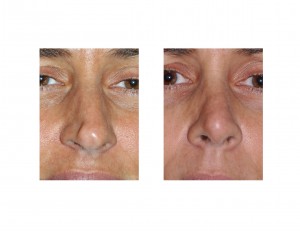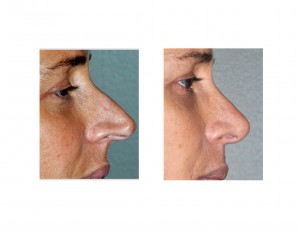Background: The nose presents a very wide array of problems for reshaping by rhinoplasty surgery. There are nearly a dozen different pieces of anatomy to the nose and how they arranged and their size is what creates the diversity of the shape problems seen. But there are a handful of common problems that the rhinoplasty surgeon can encounter and one of those is the long nose.
The long nose or the overprojecting nose is one that sticks out too far from the face. It is most commonly caused by the lower alar cartilages, known as the LLC, which stick too far out on the face due to being overgrown. The paired LLCs play a major role in the shape of the nasal tip so if they are too long, in conjunction with the central end of the septum, the nose will be too long. They are measurements that can be used to determine tip projection but the most important measure is what the patient and the plastic surgeon see.
The projection of the nose can have a major role in determining facial attractiveness. In the July 2011 issue of the Laryngoscope, an article was published entitled ‘Nasal Tip Projection and Facial Attractiveness’. Doing a photographic analysis of 300 young women, six nasal tip projection ratio were measured in each picture.They found that none of the nasal tip ratios necessarily correlated with facial attractiveness. However as nasal tip projection deviated from the ideal measurement, facial attractiveness was judged to decrease.
In the overprojected nose, the major rhinoplasty goal is to bring the tip back in and closer to the face. (deprojection of the nasal tip) In some patients, this can be accomplished by reduction of where the LLC comes together over the tip known as the dome. In other patients, the height of the nasal bridge is also too high and it must be reduced as well as the tip to bring the nasal tip closer to the face. As the tip is deprojected, the tip of the nose in many patients must also be rotated slightly upward for a better aesthetic and proportioned appearance.
Case Study: This 42 year-old female was bothered by her very long nose and wanted it reshaped to be shorter and more proportionate. In addition, her nose was twisted at the tip and deviated to one side. She had trouble breathing through the left side of her nose as well.


Case Highlights:
1) A long nose, also known as an overprojected nose, is one that sticks out too far from one’s face due to long LLCs and septal length.
2) Shortening the long nose can be done very effectively by an open rhinoplasty where the tip is shortened and the height of the bridge is reduced.
3) With significant tip shortening some tip rotation may be needed as well.
Dr. Barry Eppley
Indianapolis, Indiana


